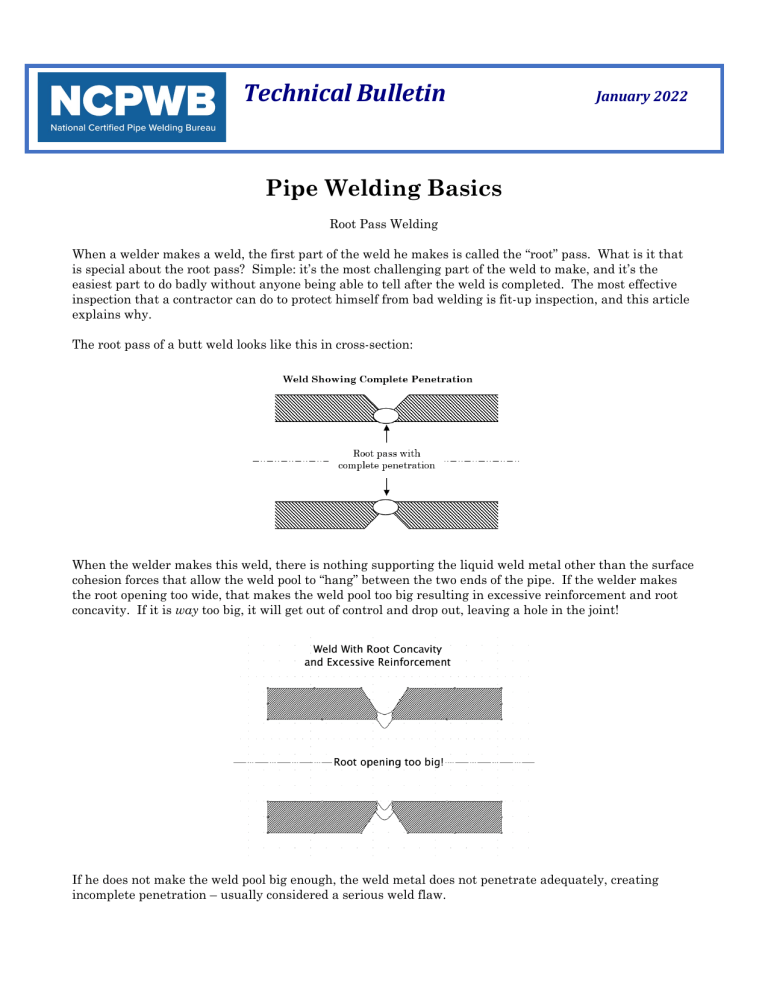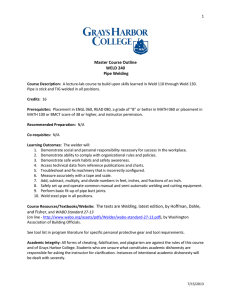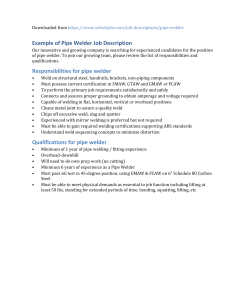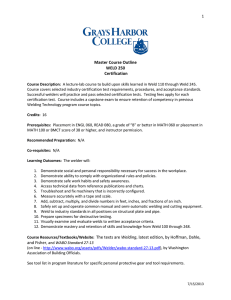
Technical Bulletin January 2022 Pipe Welding Basics Root Pass Welding When a welder makes a weld, the first part of the weld he makes is called the “root” pass. What is it that is special about the root pass? Simple: it’s the most challenging part of the weld to make, and it’s the easiest part to do badly without anyone being able to tell after the weld is completed. The most effective inspection that a contractor can do to protect himself from bad welding is fit-up inspection, and this article explains why. The root pass of a butt weld looks like this in cross-section: When the welder makes this weld, there is nothing supporting the liquid weld metal other than the surface cohesion forces that allow the weld pool to “hang” between the two ends of the pipe. If the welder makes the root opening too wide, that makes the weld pool too big resulting in excessive reinforcement and root concavity. If it is way too big, it will get out of control and drop out, leaving a hole in the joint! If he does not make the weld pool big enough, the weld metal does not penetrate adequately, creating incomplete penetration – usually considered a serious weld flaw. In order to get full penetration and get the weld pool size right, the welder has to control the fit-up, the current, the electrode travel speed and, for TIG welding, the wire feed speed. This requires a modestly skilled welder and a properly prepared bevel on both members being joined. Obviously, making an “open root” root pass is a challenge. Can we make it easier for the welder to make a fully-penetrated root pass? A very old practice in pipe welding is to use a backing ring. A backing ring is also known as a “chill ring” because it accelerates solidification of the weld pool. Backing rings are nothing more than a strip of metal rolled up to fit inside the pipe and span the gap between the pipe ends; this gives the welder something to weld against. There is a large gap between the ends of the pipes to be joined, making fit-up easier and quicker, and it ensures that the weld will be fully penetrated. A backing ring physically supports the weld metal when the welder is welding on the top of the pipe. When the welder is welding on the bottom of the pipe, the backing ring increases the contact surface area for the weld metal, helping it stay in place even though the weld pool may be somewhat large. Backing rings are not, however, a universal good. With proper control of water chemistry and the water flow rate, backing rings have been used successfully in steam and water service with thousands of welds. There are sometimes objections to using them in other services: • • • • A backing ring extends into the fluid flow and may cause excessive turbulence; commercial backing rings have a smooth convex surface on the inside to minimize this. There is a gap between the backing ring and the pipe wall that can be a site for accelerated corrosion when used on stainless steel and similar high-alloy materials, so backing rings are hardly ever used in water service when these materials are specified. The gap between the backing ring and the pipe wall can trap dirt, bacteria or other contamination which may affect the product inside the pipe. The gap can trap slag which may result in a reject if the joint is radiographed. Only the engineer who understands the service needs can determine if a backing ring is suitable for the service conditions. Another approach to making it easier to make the root pass is to weld the joint from both sides. With this approach, one side of the joint is welded completely or partially, then the other side of the joint is background to sound metal and welded from the second side. This approach is not common in ordinary piping since it only works when the inside of the pipe is accessible, but contractors should keep in mind that it is perfectly acceptable to weld a joint from the root side when the inside surface is accessible, such as at a butt weld flange or when welding large pipe. Another approach is to use GTAW and a consumable insert. One of the skills necessary with GTAW is to be able to add filler metal to the joint at just the right time and at the right rate to keep the weld pool size correct. A consumable insert is filler metal that has been flattened and formed into a ring and placed in the root of the joint. This eliminates the need for the welder to precisely control filler metal addition since the filler metal is already where it needs to be. Consumable inserts are commonly used where welds will be radiographed, but they should be considered for other applications, too, since it is a little easier to learn to weld using an insert than it is to learn to make a weld “open root.” Unlike a backing ring, consumable inserts are completely melted during welding, and the resulting root pass is identical to one made welding open root. Yet another approach to making a root pass using GTAW is to simply machine the ends of the pipe square and butt them together. This is a common practice with Schedule 10 stainless steel in the pharmaceutical, food processing and microprocessor industries. Usually, the pipe is welded using machine or automatic welding equipment. Another approach when welding from one side of a joint is to use nonfusing metal or nonmetallic retainers. A “retainer” serves the same purpose as backing except that it is always removed after welding is completed. A nonfusing metal retainer is typically a large, thick bar of copper. It is placed at the root of the weld just like a large steel backing ring, but because the root spacing is small, the arc does not penetrate into the copper backing bar, so the weld metal does not melt into the bar; since the liquid weld metal that drops through the groove is quenched by the copper backup bar without melting into it (this is what makes the copper bar “nonfusing”), the bar can be readily removed afterwards. One can also use a high-temperaturestable nonmetallic material like ceramic or fiberglass tape and accomplish the same goal. Single Vee-groove weld made using a massive copper backup retainer Nonfusing metal and nonmetallic retainers are rarely used in pipe butt welding since removing them after welding would be difficult, but they are common in making longitudinal seam welded pipe and for vessel work. The other type of root pass common in piping is the one that is made on a socket welded joint. While this joint is much simpler to make than an open root joint, welders will occasionally not use sufficient current or poor technique, and that results in incomplete penetration in the root as shown below. While this flaw is ordinarily undetectable, owners will sometimes radiograph socket welds looking for the small gap between the end of the pipe and the bottom of the socket and discover incomplete penetration. While there is no requirement to have a gap after welding, incomplete root penetration typically requires remedial action such as grinding out the weld and rewelding or adding more filler metal to increase the weld throat thickness. Member inquiries about welding may be directed to Mr. Sperko at 336-674-0600 or at wsperko@bellsouth.net. Contributed by Walter J. Sperko, P.E., NCPWB Consultant President of Sperko Engineering http://sperkoengineering.com/






